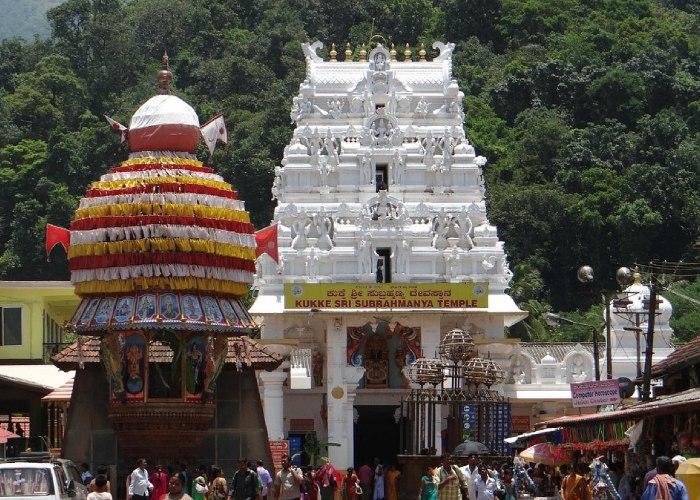Notifications

8 minutes, 10 seconds
-25 Views 0 Comments 0 Likes 0 Reviews

Nestled in the lap of the Western Ghats of Karnataka, the Sri Kukke Subramanya Swamy Temple is one of South India’s most revered pilgrimage destinations. Surrounded by dense forests, towering hills, and sacred rivers, this temple is a haven of spiritual energy, devotion, and divine mystery. Pilgrims from across India flock to this holy site to seek the blessings of Lord Subramanya, the powerful deity associated with serpents and protection from negative energies.
The Sri Kukke Subramanya Swamy Temple is deeply rooted in ancient traditions and mythologies. It is believed that Lord Subramanya, the son of Lord Shiva and Parvati, defeated the demon Tarakasura and came to reside in the forests of Subramanya. Here, he was welcomed by the divine serpent Vasuki, and ever since, the temple has been associated with serpent worship. Pilgrims come here to perform rituals for relief from Sarpa Dosha, a spiritual affliction believed to arise due to ancestral curses or snake-related sins.
The temple’s main sanctum features the deity Lord Subramanya along with the serpent king Vasuki. Devotees believe that praying here helps alleviate problems related to marriage, childbirth, and mental peace. The temple has gained a reputation for being particularly powerful and effective in fulfilling the wishes of its devotees.
One of the most enchanting aspects of visiting the Sri Kukke Subramanya Swamy Temple is the journey itself. Located in the small town of Subramanya, around 280 kilometers from Bengaluru, the route to the temple is dotted with lush greenery, winding roads, and the majestic view of the Kumara Parvatha hills. The air is pure, and the atmosphere is filled with serenity, making the pilgrimage feel like a spiritual retreat.
Upon reaching the temple, visitors are often struck by the calm yet powerful energy that envelops the entire space. The chants of mantras, the fragrance of incense, and the sight of rituals being performed create a sacred ambiance that touches every soul. It is not just a temple visit—it’s an experience of connecting with something much greater than oneself.
One of the most significant rituals performed at the temple is the Sarpa Samskara, a unique ceremony aimed at removing the effects of serpent curses. This ritual can last for one or two days and is guided by experienced priests who follow sacred procedures passed down over generations.
Another prominent ritual is Ashlesha Bali, performed on specific star days for spiritual cleansing. Devotees believe these rituals bring them immense peace and resolve long-standing problems. The temple also performs daily pujas, homas, and abhishekas (holy baths of the deity), which visitors can witness and participate in.
According to legend, after vanquishing the demon Tarakasura and his brothers, Lord Subramanya came to this forested region to rest. He chose this serene environment to merge with the divine energy of Vasuki, the serpent king, who was performing penance here to escape from Garuda, the eagle vehicle of Lord Vishnu. The union of Subramanya and Vasuki is symbolic of harmony and protection, and it is this story that gives the temple its spiritual prominence.
The historical roots of the Sri Kukke Subramanya go back centuries, and the temple has been mentioned in various Puranas and ancient texts. Its spiritual power and historical richness have made it one of the holiest shrines in southern India.
Pilgrims often extend their journey to explore temples near Kukke Subramanya, each with its own story and divine essence. The Adi Subramanya Temple, located nearby, is one such place that holds great importance. Here, the deity is believed to have first manifested before settling in the main temple. The site is serene and spiritually charged, offering visitors a quiet space for reflection and prayer.
Another important temple in the vicinity is the Adi Subrahmanya Temple, which, despite sounding similar, is considered a distinct location where unique rituals are performed. These temples complement the spiritual journey of devotees and offer a fuller, richer experience of devotion.
While Kukke Shri Subrahmanya is the most well-known among Lord Subramanya's temples, it shares spiritual links with other shrines across India, such as the famous Subramanya Temple in Mysore. Each temple honors the warrior god in a unique way, highlighting different aspects of his divine persona—from the fierce vanquisher of evil to the benevolent protector of devotees.
These connections illustrate the widespread reverence for Subramanya across cultures and regions. The devotion seen in Kukke reflects a broader, pan-Indian admiration for this deity, known for courage, wisdom, and compassion.
The Kukke Shree Subrahmanya Temple has not only retained its ancient charm but has also embraced modern developments to make the pilgrimage more accessible. There are accommodations for devotees, organized darshans, and clear guidance for performing rituals. Despite modern touches, the spiritual sanctity remains untouched.
Celebrities, politicians, and spiritual leaders frequently visit this temple, reinforcing its reputation as a must-visit divine destination. The temple has also played a role in community development and charity, supporting educational and cultural initiatives in the region.
Visiting the Kukke Shree Subrahmanya Temple is not merely about religious rituals; it is about experiencing the profound presence of the divine in a setting untouched by time. The temple’s powerful aura, natural surroundings, and deep-rooted mythology come together to create an unforgettable journey.
Whether you are spiritually inclined, seeking solutions to life’s problems, or simply exploring India’s rich cultural heritage, the Sri Kukke Subramanya Swamy Temple offers a profound experience. As you step out of this sacred space, you carry with you not just blessings, but also a renewed sense of inner peace and clarity.

